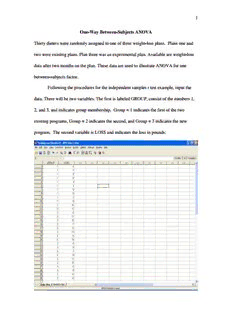
Between-Subjects ANOVA One- and Two-Way (pdf format) - plaza PDF
Preview Between-Subjects ANOVA One- and Two-Way (pdf format) - plaza
1 One-Way Between-Subjects ANOVA Thirty dieters were randomly assigned to one of three weight-loss plans. Plans one and two were existing plans. Plan three was an experimental plan. Available are weight-loss data after two months on the plan. These data are used to illustrate ANOVA for one between-subjects factor. Following the procedures for the independent samples t test example, input the data. There will be two variables. The first is labeled GROUP, consist of the numbers 1, 2, and 3, and indicates group membership. Group = 1 indicates the first of the two existing programs, Group = 2 indicates the second, and Group = 3 indicates the new program. The second variable is LOSS and indicates the loss in pounds: 2 Click Analyze→General Linear Model→Univariate. The following screen is displayed: Using the usual process, move GROUP to the Fixed Factors slot and LOSS to the Dependent Variable: slot. The screen will look like: 3 Click Options to get the following screen: Check Descriptive statistics: 4 Click continue: Click OK. 5 Univariate Analysis of Variance [DataSet2] C:\6481\spss\Bsanova\oneway.sav Between-Subjects Factors N GROUP 1 10 2 10 3 10 Descriptive Statistics Dependent Variable: LOSS GROUP Mean Std. Deviation N 1 4.90 2.079 10 2 10.20 1.874 10 3 9.20 2.251 10 Total 8.10 3.078 30 Tests of Between-Subjects Effects Dependent Variable: LOSS Type III Sum Source of Squares df Mean Square F Sig. Corrected Model 158.600a 2 79.300 18.442 .000 Intercept 1968.300 1 1968.300 457.744 .000 GROUP 158.600 2 79.300 18.442 .000 Error 116.100 27 4.300 Total 2243.000 30 Corrected Total 274.700 29 a. R Squared = .577 (Adjusted R Squared = .546) 6 Two-way Between-Subjects ANOVA Available are discrimination indices for 24 American cities. To study the relationship of the index to size of city and region, a sociologist categorized the cities in terms two factors: size of city (over or under 150000) and region (northeast, north central, south, and west). Note that there is one score per city and the cities are the subjects. Bothe factprs are between-subject because there are different cities in each combination of size and region and there is not another variable on which blocking was conducted. Following the procedures for the independent samples t test example, input the data. There will be three variables. The first is labeled SIZE, consists of the abbreviations S and L (for small and large), and indicates the levels of the SIZE factor. The second is labeled REGION, consists of the abbreviations NE, NC, S, and W (for northeast, north central, south, and west), and indicates the levels of the REGION factor. The third is labeled INDEX and indicates the city’s score on the discrimination index. If you display the Variable View you will find that SIZE and REGION are string variables rather than numeric variables. 7 Click Analyze→General Linear Model→Univariate. The following screen is displayed: 8 Move SIZE and REGION to the Fixed Factor(s): slot and INDEX to the Dependent Variables slot: 9 Click options to display this screen: Move SIZE and REGION to the Dsiplay Means for: slot and check Descriptive statistics: 10 Click Continue: Click OK.
Description: